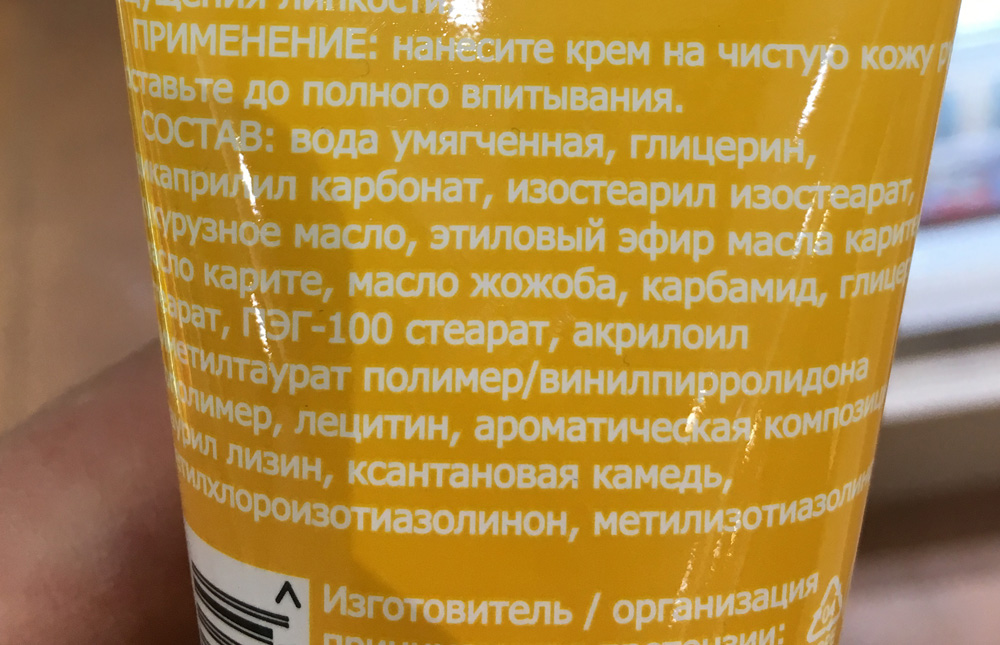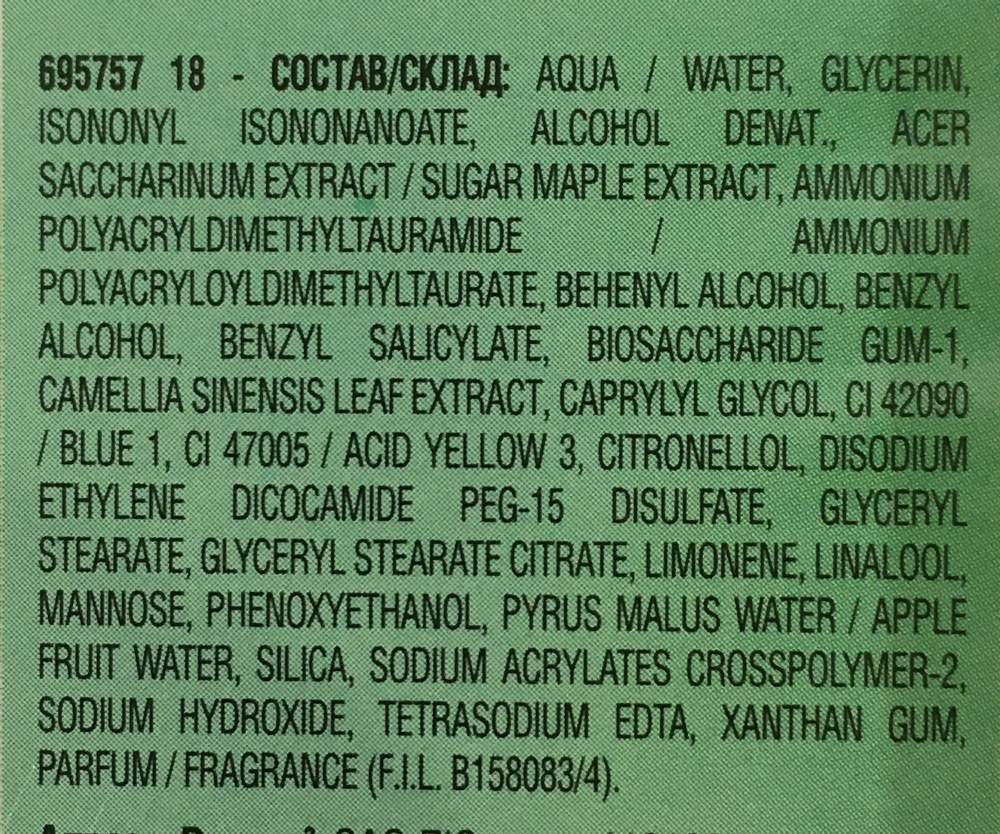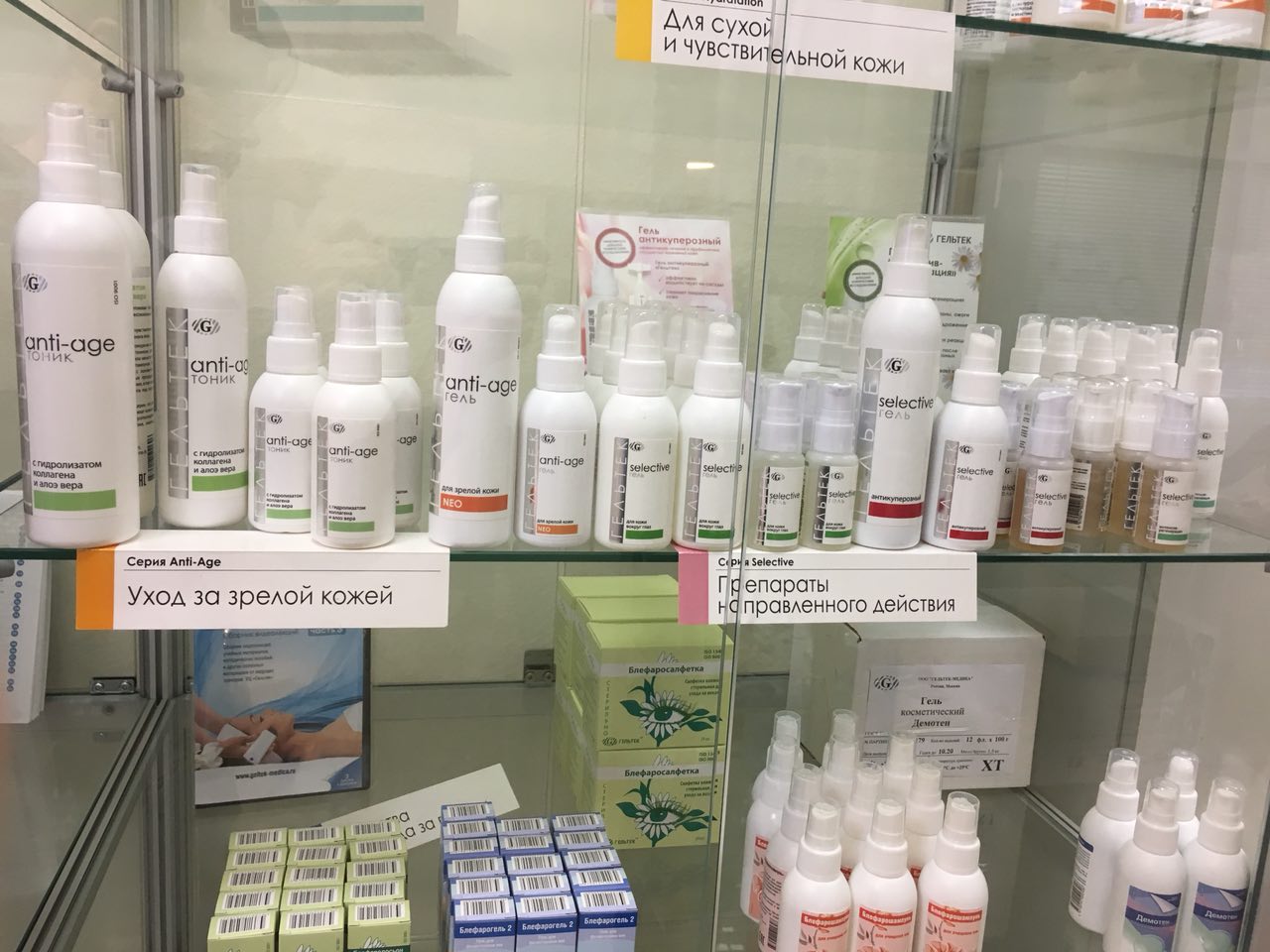
The ingredients are listed by lowering the mass fraction: which is closer to the beginning, the more mass. Substances that are less than 1% in composition are considered equivalent for this list, and they can be indicated after the main ones in any order. In the Russian Federation, according to the law, everything is indicated without exception (there is no situation when a substance can be left out with a low content), and in practice this is observed. Why - just below.
You can not write "preservative" without specifying what it is, you can not write the "mineral complex of acids" without detail, what it is, but you can write commercial names. That is, register your mineral acid complex or preservative as a trademark - and write it already. You can write chemical names or trade, and it is possible both in Latin and Russian. In incomprehensible substances, for example, often hide what suspicious women do not want to see on the label.
In this case, you can write "perfume" or "sulfur preparations" - this is to protect the know-how, so as not to show the formula. For example, on Blefarogel 2, we have just this: we don’t really want our competitors to know right away what kind of drugs, let them suffer from the tests.
Security
What will happen if you do not specify something? Kirdyk noggin. From a large fine to criminal liability. If the consumer writes a complaint about something that is not in the declaration, it is a withdrawal of the entire party, a refund, the courts. It is possible to survive, but among retail chains this is considered to be a moveton, it will be much more difficult to work further.
Similarly, during the inspections on the production look composition. No one left alive from Rospotrebnadzor. And what is the coolest - they are not for sale. That is, they can not be bought at all. In Moscow at least. Contrary to popular myth.
Checks are made planned and on demand. Sometimes they come on tips, on complaints, sometimes just spontaneously falling checks. They come a lot and often, and every time they sincerely hurt them just to go. Therefore, they are always looking for what and where is not so that it is not in vain to drive.
Well, in general, it’s more expensive to hide something simply: each of the substances is a potential allergen, and the inscription on the box reliably protects the manufacturer from ships. "Allergy? Did you read the composition? And the instructions? Not? Then what are we talking about? ”
If the tool is allowed to use, then most likely everything is fine there.
In general, the maximum that you may encounter in terms of danger when you buy cosmetics certified for the Russian Federation is individual intolerance.

Preservatives and packaging
Imagine a jar of cream (not a tube, but a jar). With each use, you will touch the surface of the cream with your finger and leave a multitude of microorganisms on it. Do medical students one of the first classes - is to make the crops with their own hands. Someone finds E. coli (because you need to wash your hands after using the toilet), someone else has interesting things. Even if you wash your hands, it can still settle in a cream. For example, look at the instructions for medical bacteriophages - they are supplied in a nutrient solution, and there they are described in very detailed ways how to open them, how to wash hands and a knife to open, how to pour, how to close, how to store, how to check that nothing has grown yet. . This is because we always carry on hand something in minimal quantities. And much more just flies in the air with droplets of moisture.
So, you open the cream and juicy finger over it. From this point on, it becomes the Petri dish for breeding microorganisms. Of course, the manufacturer insures you against some problems by adding more preservative to the product, but it doesn’t help against fungal infections.
Further option: either make a professional packaging (small cans and disposable spatulas), or switch to gels or creams from the tubes. Well, or to put a complex of parabens in a rather tangible amount, because
parabens are antifungal agents, and no citric acid, no natural preservatives solve this question for them. That is, it is possible to significantly reduce the load of preservatives by making a package with any non-contact dose dispensing method: these are droppers, pipettes, sprays, dispensers or disposable packages.
Yes, by the way, being afraid of parabens, remember that these are natural preservatives that are available in cranberries and lingonberries in fairly large doses. But it is an ester of benzolic acid, which is simpler, cheaper and cleaner to obtain from petroleum products. These synthesized substances are used not only as a preservative of cosmetics, but also in medicine, for example, in eye drops or means for mucous membranes - where there is no sterility.
Yes, there are cosmetics without preservatives. It is usually sold out of the refrigerator, you have to carry it home quickly or in a thermo bag, at home, too, put in the refrigerator. And her shelf life is three days. For obvious reasons, this is unlikely you will find in the mass market, therefore - everything that you smear on yourself, one way or another with preservatives.
Once, as part of an internal experiment, our laboratory made a moisturizing gel for the skin without any preservatives at all. One of the samples was accidentally forgotten on my desktop. And then we went to the conference for a week. The specimen blossomed and seems to have tried to make contact with other intelligent life forms. Airing the office for two hours. For a week or two at room temperature, any active drug turns into just unclear what, if it is not processed by conservation. Preservatives are needed to protect the end customer - yes, there are many myths about them, but in reasonable quantities they are simply necessary.
Each preservative is an allergen, as a rule. And they are very expensive (both the substances themselves and their input into the formula), so do not think that manufacturers shift them. Our solution is no cans, only bottles.

Features of human interaction
Micellar water and all surfactants (surfactants) should be washed off with water or tonic (it is necessary to normalize the pH). Even if the instructions say something like “wash it and go for a walk” - you need to wash it off, otherwise your skin will not be very good.
Now look at the base. Usually, the base is either water or something fat (for a cream). There is oil in water, emulsion. Therefore, we must clearly understand what the tool is and on what basis you have in your hands. If it says "cleansing oil" - it should cause the same hysteria of laughter as the inscription on the pillow "protects against electromagnetic radiation." Any application of oil to the skin is
comedogenic , that is, clogs the pores. It is always necessary to always flush the face, from other places - it is desirable if you do not solve a medical problem with this.
Glycerin 40% pulls water. If it is less, for example, 30%, then not, therefore it is usually put 1–2%.
Hyaluronic acid is almost absent in creams, at most 0.1% by weight approximately, then the whole structure becomes sticky. The cream is no longer smeared, but applied as strong Siberian snot. But in the gel, it enters normally, because it perfectly absorbs water. Also a reason to produce gels instead of cans of creams.
Nothing cosmetic can cure, it is forbidden to write about the healing effect on the labels. Another thing is that we usually have: first we get permission for a cosmetic product, and then after a couple of years - for a medical product. So we had the same Blefarogel 1, for example. Or here is the “Rescuer” ointment - it is cosmetic, but a second-degree burn clears up in 8 hours. Our “Intensive Regeneration” is also a cosmetics, but it copes in 6 hours already (although we will not be selling it as cosmetics in foreign markets).
The big myth about the division into segments for luxury, mass-market and professional. This is absolutely the same from about the same suppliers of raw materials. But someone has been testing longer and people are better, someone has been marketing geniuses. By law, there can be three types of cosmetics:
- Special purpose (for intimate places, children)
- Not for use by the end user (it is with strong acids and alkalis up to 8%, caustic paints, brutal pilinigi, etc. - all this is used in the showrooms by a strictly specialist with good safety, but not for ordinary people).
- And just ordinary cosmetics. All that you can buy in the store (regardless of price) has the same control and the same certificates.

Active substances
Active substances are very expensive. And not any special, but everything - from hyaluronic acid, even in the high molecular weight fraction and ending with D-panthenol, chitosan and other rarer compounds. A happy exception is the extracts (for example, chamomile extract, obtained in a huge tank with chamomiles and chemical agents that produce this extract from raw materials - it is very cheap). Therefore, if you sell something that consists only of extracts, they save you money.
For the price is still important time to develop and balance this formula and the mass fraction of active substances. Therefore, for example, we did not hit the market with the price of the means for regeneration.
Although there was one poison snake in our run-in, which cost 10 thousand euros for 20 grams. Here it is expensive.
More peptides cost about 120 thousand rubles per 10 grams. By the way, the sample was brought in a flask (imagine, an incomprehensible hairy person in a leather jacket comes to work with you and passes the test tube with white powder). Cheaper, respectively, that is produced in Russia, and various extracts. Again, very cheap - this is also an abstraction, because, for example, there are plant extracts that are sold in a 500-kilogram barrel. And we need 71 kilograms for the year of this, for example. Or in general for a rare selective batch of 6 kilograms. And the barrel has a shelf life of three years, for example. And if you don’t spend it in a year, you have to drain it into the garbage, because your money has a minimum shelf life of two years.
Yes, about extracts: there is a myth that they somehow do not really work. Some people think that “chemistry” actually works, and extracts, in general, are added to calm you down so that you think that there is something natural there. This is true in shampoos, because the plant extract, washed off the hair in a minute - it will not give anything at all. But in cosmetics a slightly different system, especially in indelible. There they are needed, and they will not be added just like that - they make it very difficult to balance the formula. By the way, chamomile extract is now done using a cycle of chemical reactions at the production facilities (no one will ever squeeze chamomiles - they are simply put in tons into the solution, which takes the necessary substances, and then they carry out another reaction in order to get them out of the solution). All herbal extracts are not very clean, and they are all strong allergens. The future in this direction for the synthesis - to collect exactly the same thing without impurities very soon it will be easier and cheaper.
In general, the cost of cosmetics - about 30% of the price on the shelf - raw materials (including very expensive in comparison with substances packaging), 70% - work and overhead costs. And regardless of whether it is selective, “professional” cosmetics or the mass market. All the rest is development, marketing, logistics and storage and markups.
Regional features
Koreans have a different skin type and a different biology: their skin is oily and retains a long-lasting condition. The Japanese are wildly fond of Vaseline, which wasn’t even a bogey in the Russian market already. But their skin is overdried, unlike ours, so it normally comes in - it solves the main problem.
Now, about the Dead Sea cosmetics. In fact, the salts of the Dead Sea are not unique. Salt as salt. Each village has its own small salt lake, and it is not particularly different from their salts. We have Baskunchak, Olkhon, in the Novosibirsk region there are places. But there is a very good production (there is no imitation - they are really very technological), and marketing geniuses. Yes, you can do the same at home: take the salt, put it in the water, stir it up, and here's the Adriatic. The main thing is to sustain the percentage. They have a rather expensive labor force and they can afford to very much control who works for them. I personally saw the bioreactors of part of their production, they are the same as ours in the Moscow region. Plus, we still have a couple of know-hows from the USSR, to which the Israeli engineering mind has not yet reached, but these are already cavils. And yes, in the tourist shop on the waterfront, their cosmetics are still 4 times cheaper than in pro-stores in Moscow.
Frequently asked about Korean cosmetics. They have a particularly strong ethnic aspect. She is good, very good, but for Koreans and their skin. And in fact, for the most part, it does not suit us. Yes, moisturizes, they work well with gel textures, so they have a good moisturizer. By the way, they also have no creams as such - gels, serums. They are the first who with such textures drove onto the Russian market en masse.
We have a regional feature - a lot of dry skin, pretending to be oily. As a result, dry skin is raped with oily remedies and get problems. Many cosmetics are not in those temperature reactions - we have regions with excellent winters and regions with hot summers.